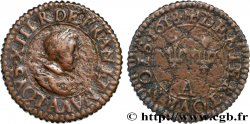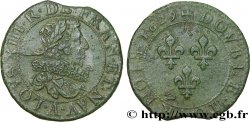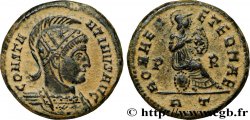Live auction - bry_986501 - LOUIS XIII Quart d'écu, à la croix fleurdelisée, titulature côté écu 1642 Poitiers
You must signin and be an approved bidder to bid, LOGIN TO BID. Accounts are subject to approval and the approval process takes place within 48 hours. Do not wait until the day a sale closes to register. Clicking on "BID" constitutes acceptance of the terms of use of cgb.fr private live auctions.
Bids must be placed in whole Euro amounts only. The sale will start closing at the time stated on the item description; any bids received at the site after the closing time will not be executed. Transmission times may vary and bids could be rejected if you wait until the last second. For further information check the Live auction FAQ
All winning bids are subject to a 18% buyer’s fee.
All winning bids are subject to a 18% buyer’s fee.
| Estimate : | 500 € |
| Price : | 300 € |
| Maximum bid : | 300 € |
| End of the sale : | 14 January 2025 16:36:24 |
| bidders : | 1 bidder |
Type : Quart d'écu, à la croix fleurdelisée, titulature côté écu
Date: 1642
Mint name / Town : Poitiers
Quantity minted : 6073
Metal : silver
Millesimal fineness : 917 ‰
Diameter : 30,5 mm
Orientation dies : 1 h.
Weight : 9,70 g.
Rarity : R2
Coments on the condition:
Ce quart d’écu est frappé sur un flan large et irrégulier. Monnaie recouverte d’une patine grise présentant quelques hairlines
Catalogue references :
Obverse
Obverse legend : .LVDOVICVS XIII. D: G. FRAN. ET. NAVA. REX. G, (LÉGENDE COMMENÇANT À 6 HEURES).
Obverse description : Écu de France couronné et accosté de II, II ; lettre d'atelier à la pointe de l'écu.
Obverse translation : (Louis XIII, par la grâce de Dieu, roi de France et de Navarre).
Reverse
Reverse legend : + SIT. NOMEN (MG) DOMINI. BENEDICTVM. (MM) 1642.
Reverse description : Croix fleurdelisée avec quadrilobe en cœur .
Reverse translation : (Béni soit le nom du Seigneur).
Commentary
Variété avec le G dans le sens de lecture des légendes et sans point avant le millésime indiquant qu’elle fut frappée durant le premier trimestre 1642 (Clairand et Wack, BSFN 2019, p. 12-17).








 Report a mistake
Report a mistake Print the page
Print the page Share my selection
Share my selection Ask a question
Ask a question Consign / sell
Consign / sell
 Full data
Full data















